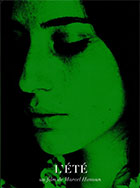
L’Ete 2016
Distributed by Re-Voir Editions Video, 43 rue du Faubourg St. Martin, 75010 Paris, France
Directed by Marcel Hanoun
DVD , black & white, 64 min.
College - General Adult
Films, Popular Culture
Date Entered: 12/21/2016
Reviewed by Oksana Dykyj, Head, Visual Media Resources, Concordia University, MontrealIt is the summer of 1968 and Marcel Hanoun’s film L’Été captures the spirit of that summer of revolution. It was shot from August 19th to the 25th after the May uprising in Paris and follows a young woman as she leaves Paris to spend time reflecting in a typical Normandy country house as she tries to get over a break up with a young man. The young woman is Graziella Buci, the young man, known as Jean-Luc (a possible nod to Jean-Luc Godard) is Pierre-Henri Deleau and her pen pal in Germany is Marianne Weber. Although the plot summary is conventional, the film is pure French New Wave.
During the summer of 1968, France, and Paris in particular was beset with demonstrations and student protest. The film opens with a collage of photos depicting the political graffiti of the time. The images are textured, documentary black and white, high contrast pictures, starting with a shot of the writing on the wall, “Qui Crée? Pour Qui?” (Who creates? For Whom?). Hanoun is the creator here and the film is very personal as if he were making it for himself. Hanoun ended up being left out of the better known French New Wave filmmakers group, and other than his first film, A Simple Story (1959) is really the only one that got any distribution in the United States. Hanoun died at the age of 82 in 2012 and by that time he had been long forgotten. It’s curious to look at his film from 1968 and to wonder why he was shunned by history. Luckily, L’Été provides an opportunity for rediscovery almost 50 years after its making. The film showcases attractive intellectuals quoting Spinoza, Hegel, Antonin Artaud and giving attribution to the political graffiti found on the walls of Paris. The girl longs for her boyfriend while writing about Michael Kohlhaas, a rebel of Saxony while she romps around the idyllic landscape and daydreams. Hanoun appears to be obsessed with her and his camera fondly reveals her body and pauses on her face.
The film is a pure document of a particular and specific period when love and revolution where the passions of young intellectuals in Paris. Experimental filmmaker Babette Mangolte is credited with additional photography and apparently contributing a hat seen on the actress. The film is brief but packs a punch. It also whets the appetite for further re-examination of the work of this filmmaker. Recommended for film studies and cultural studies.